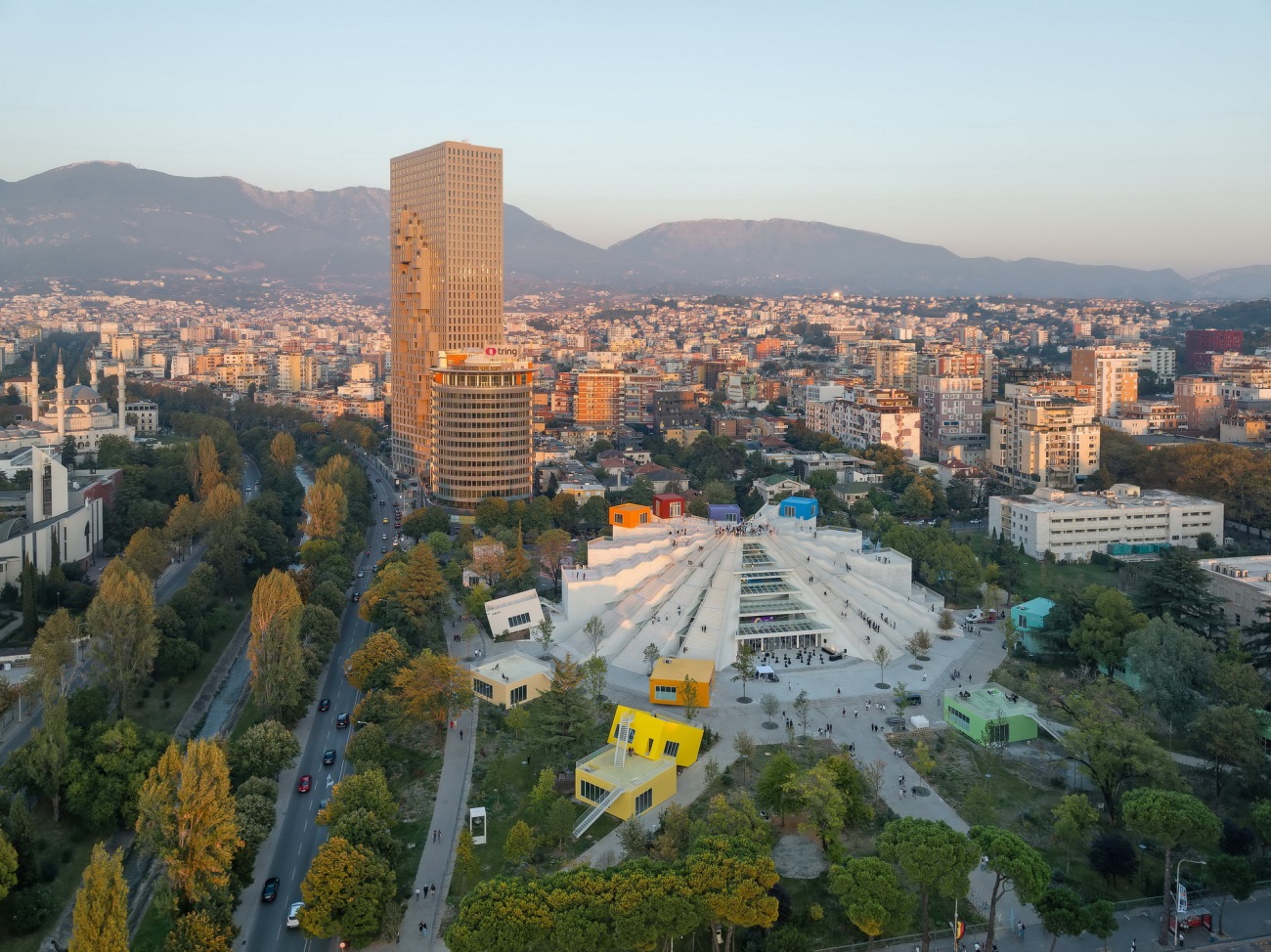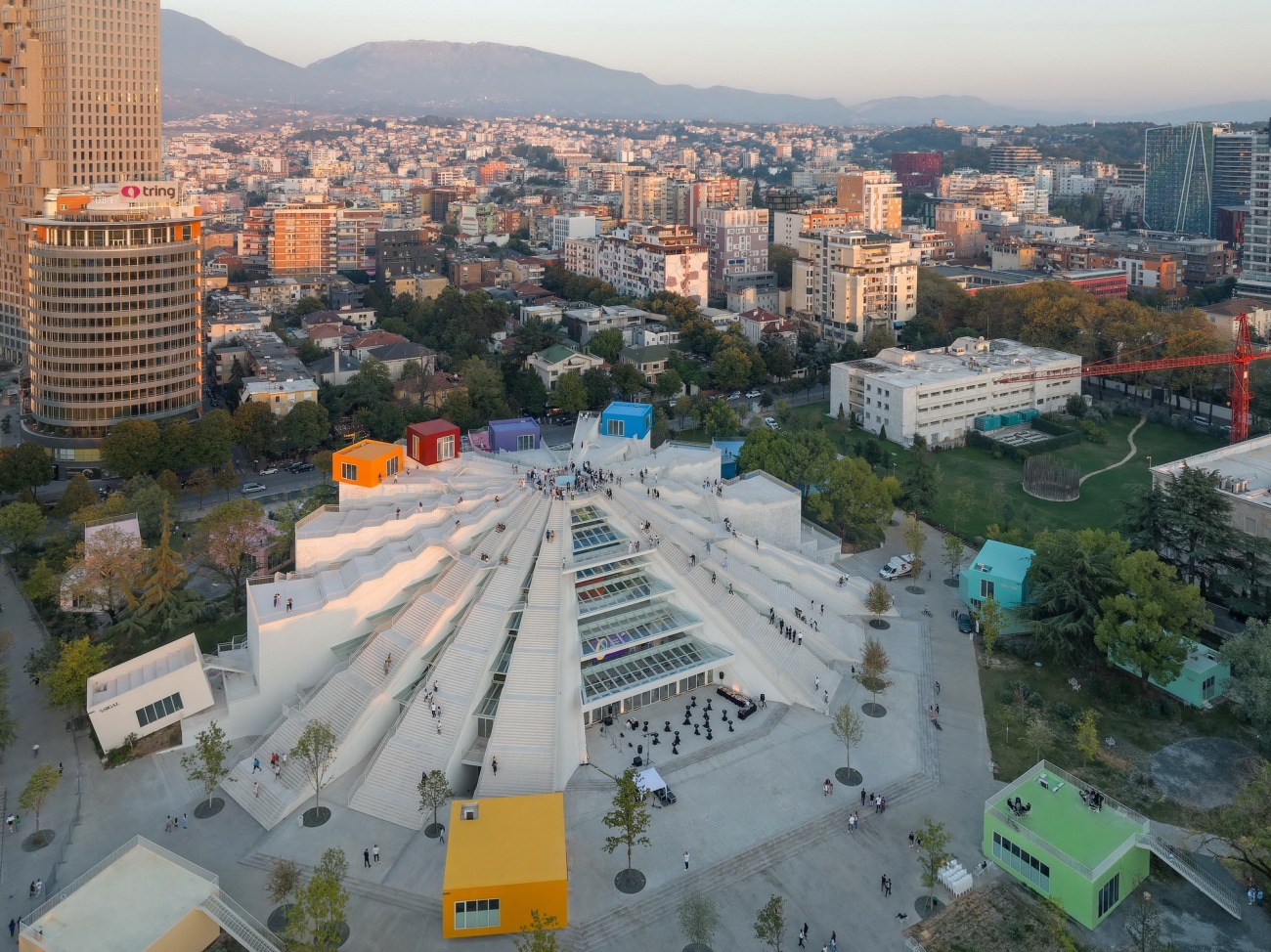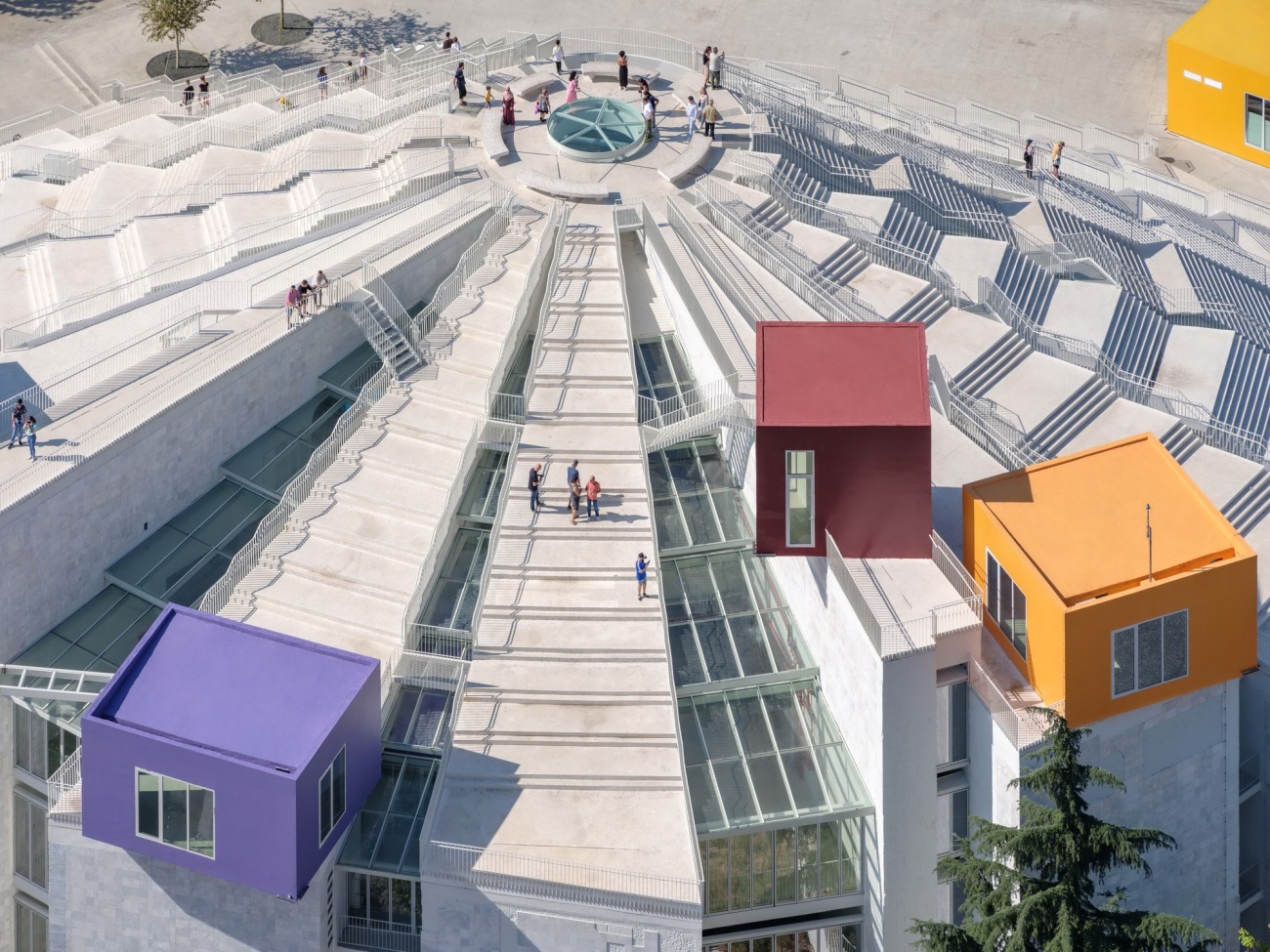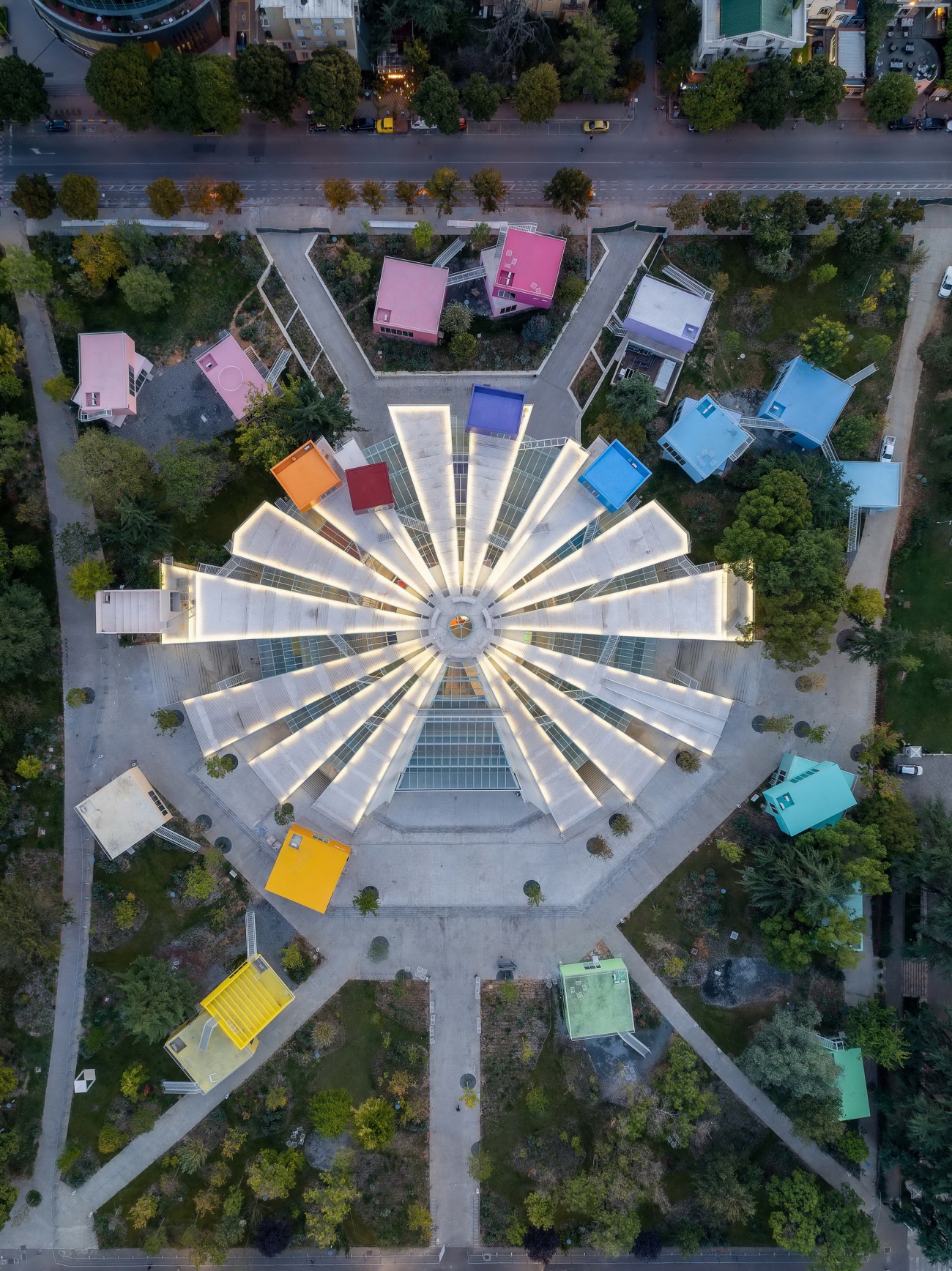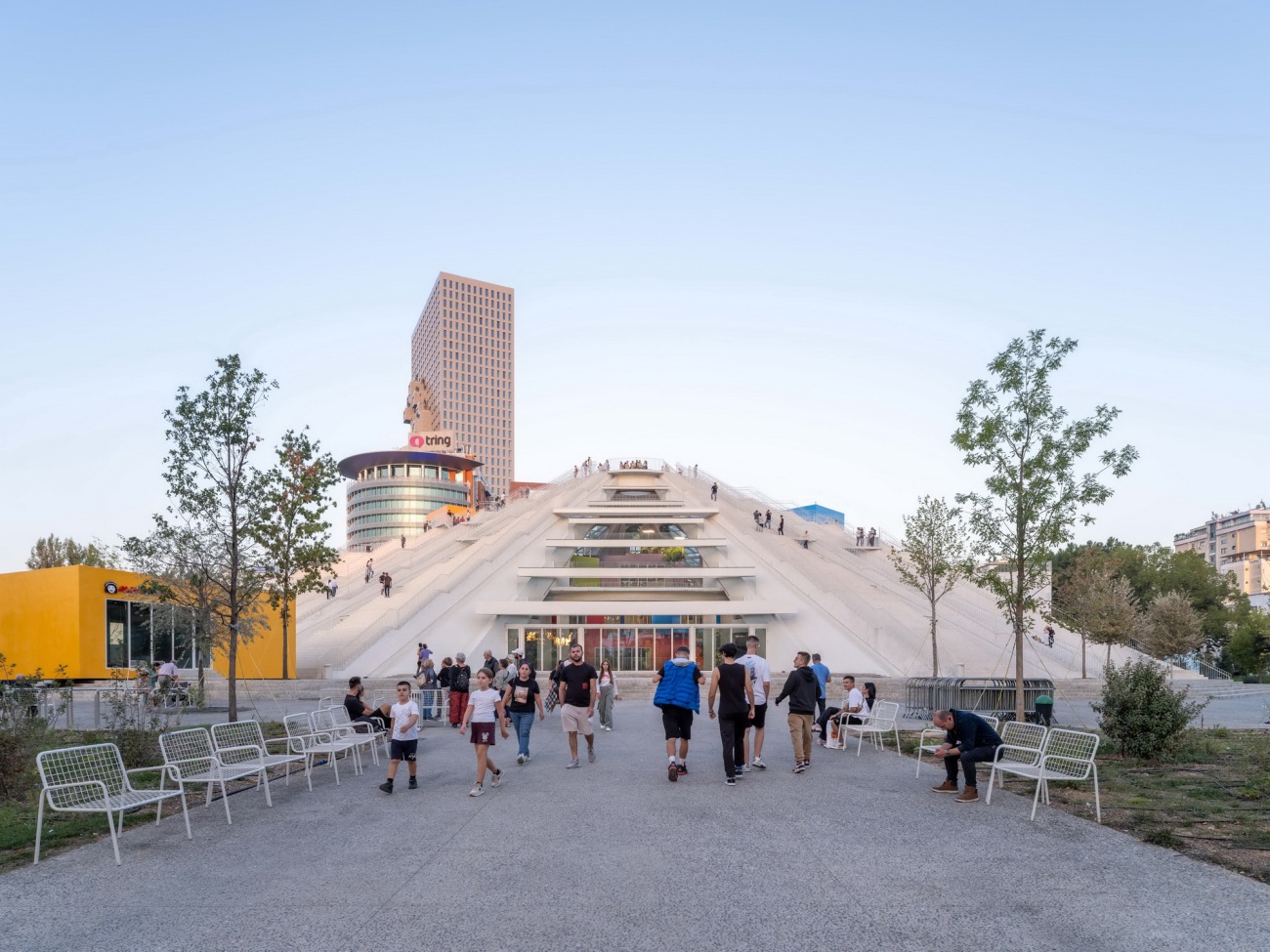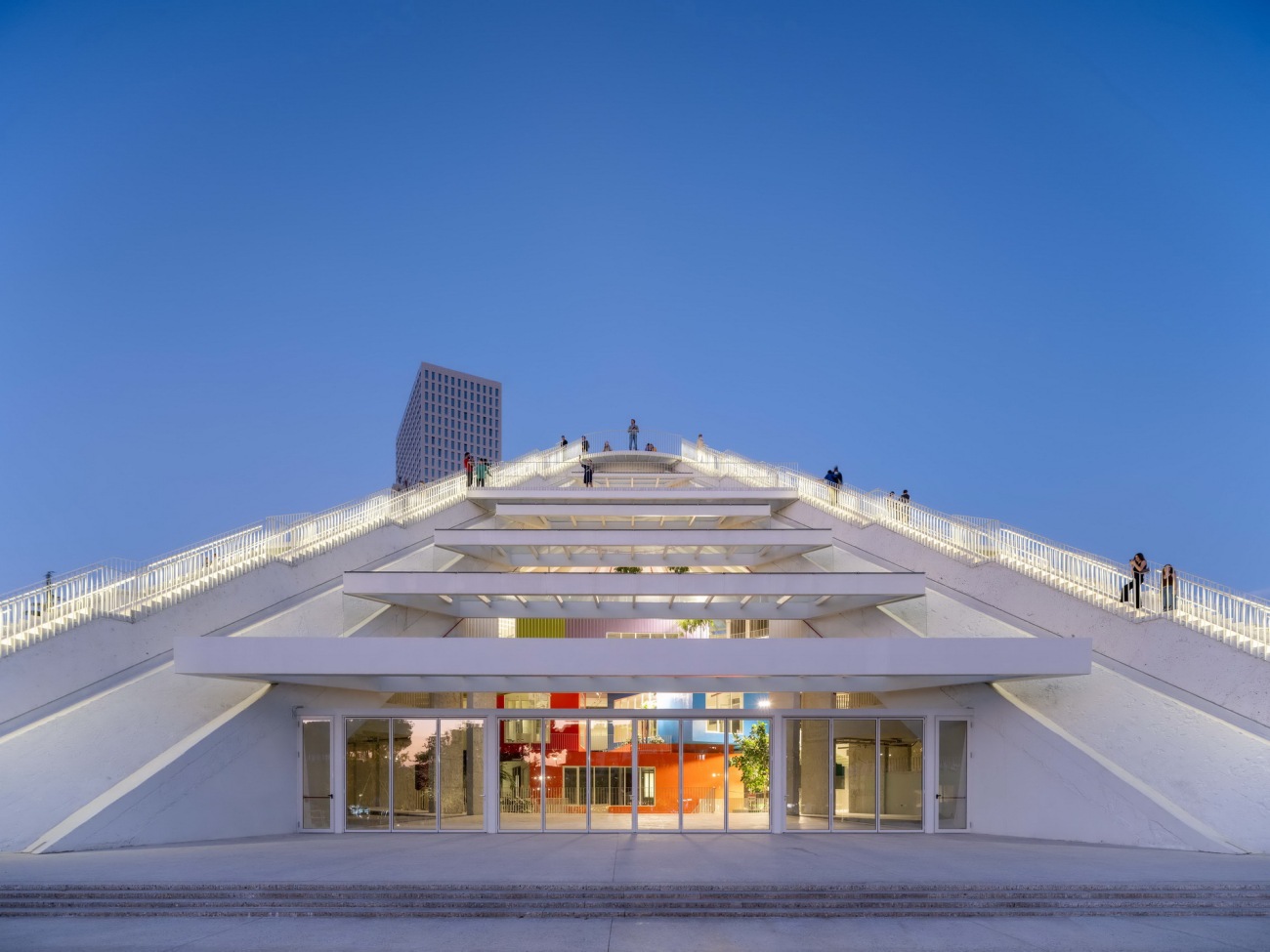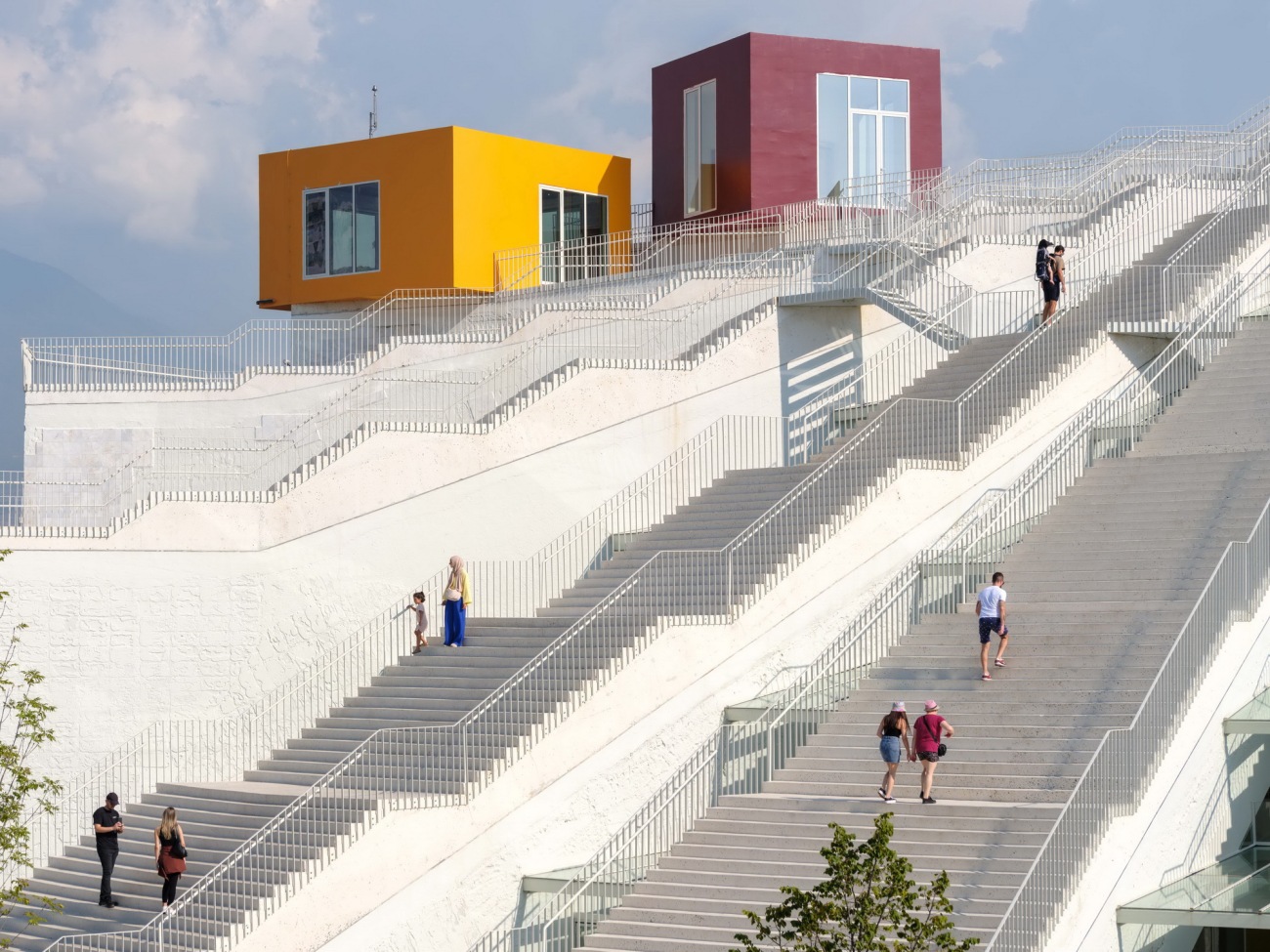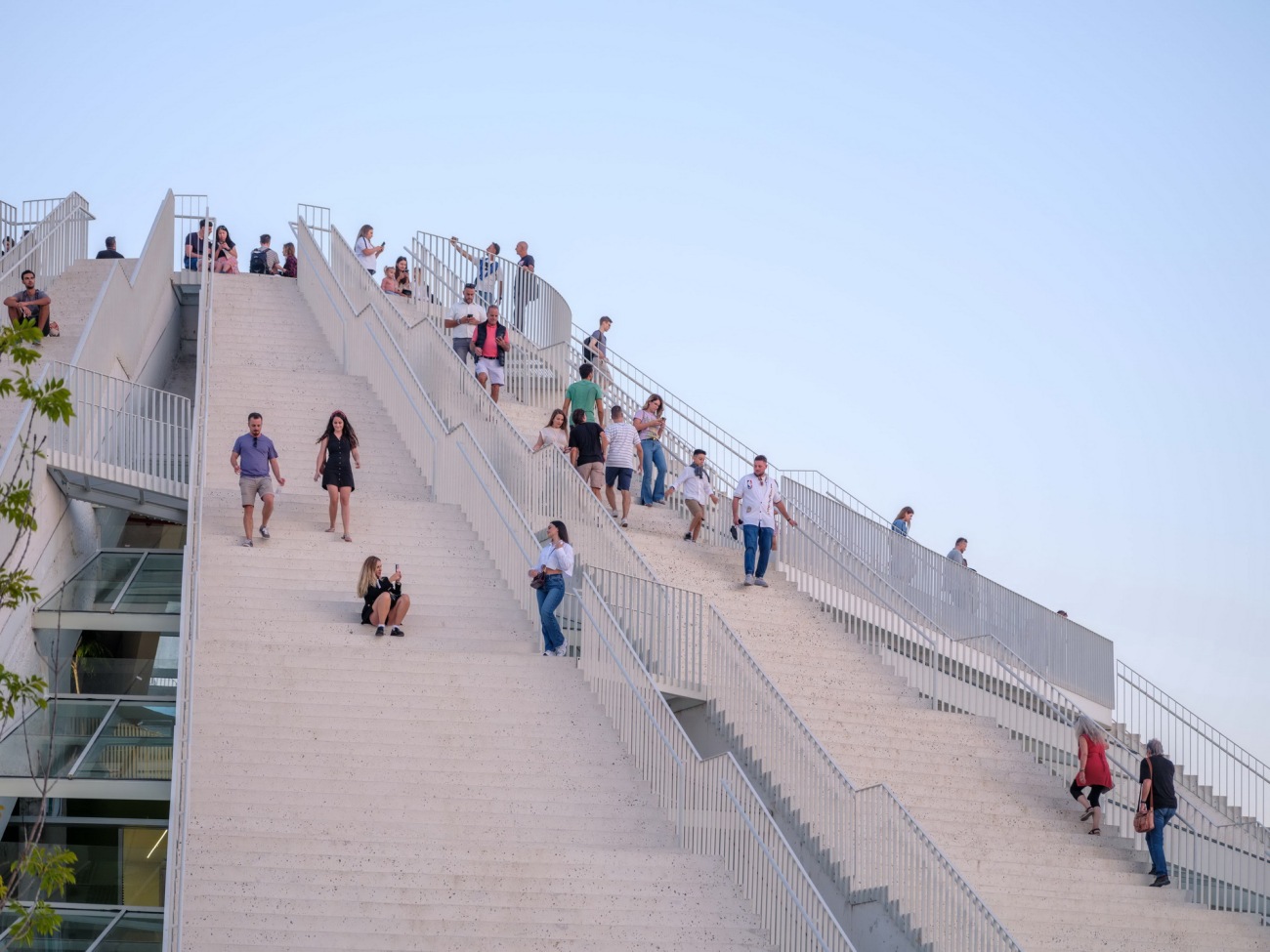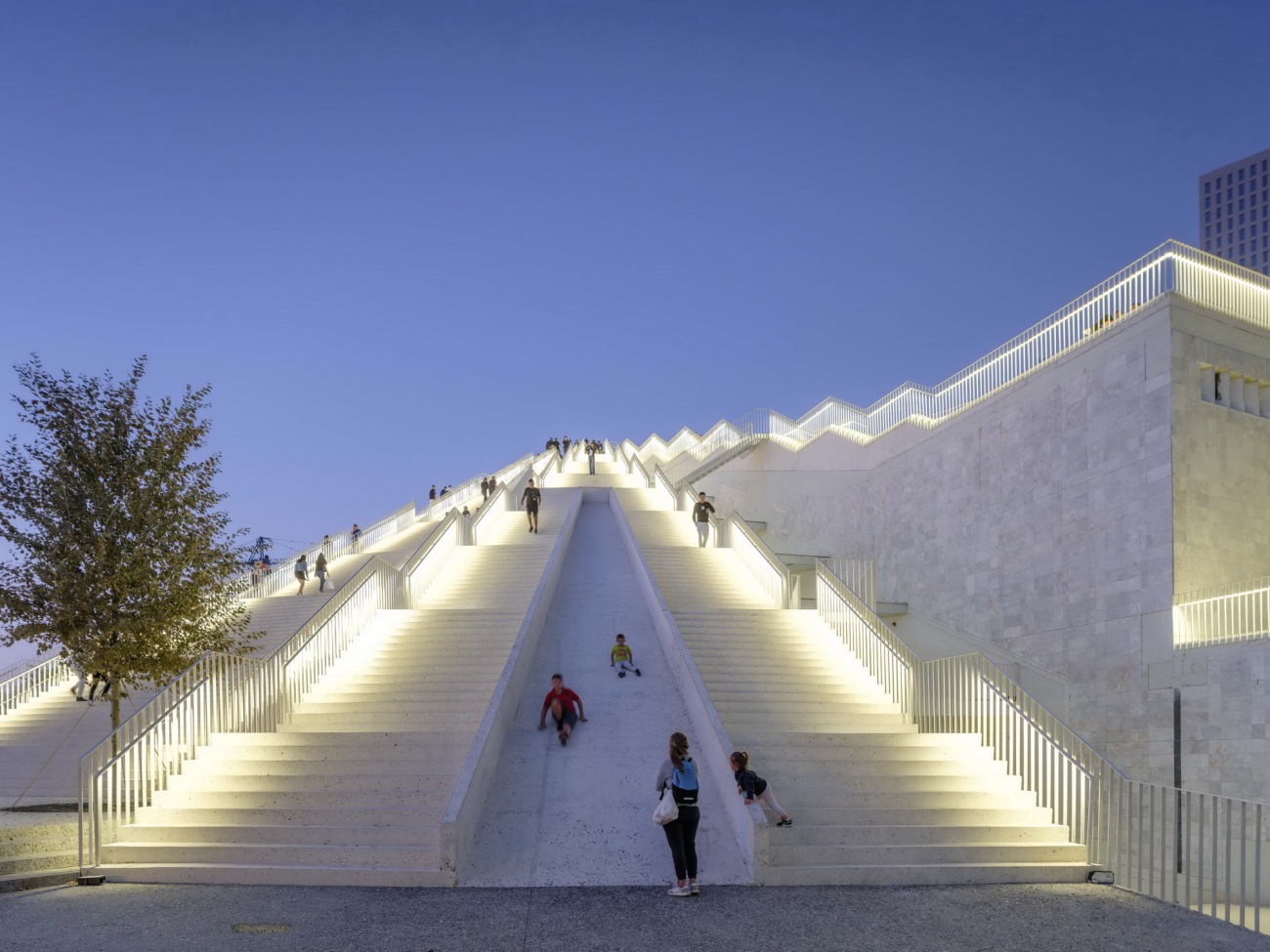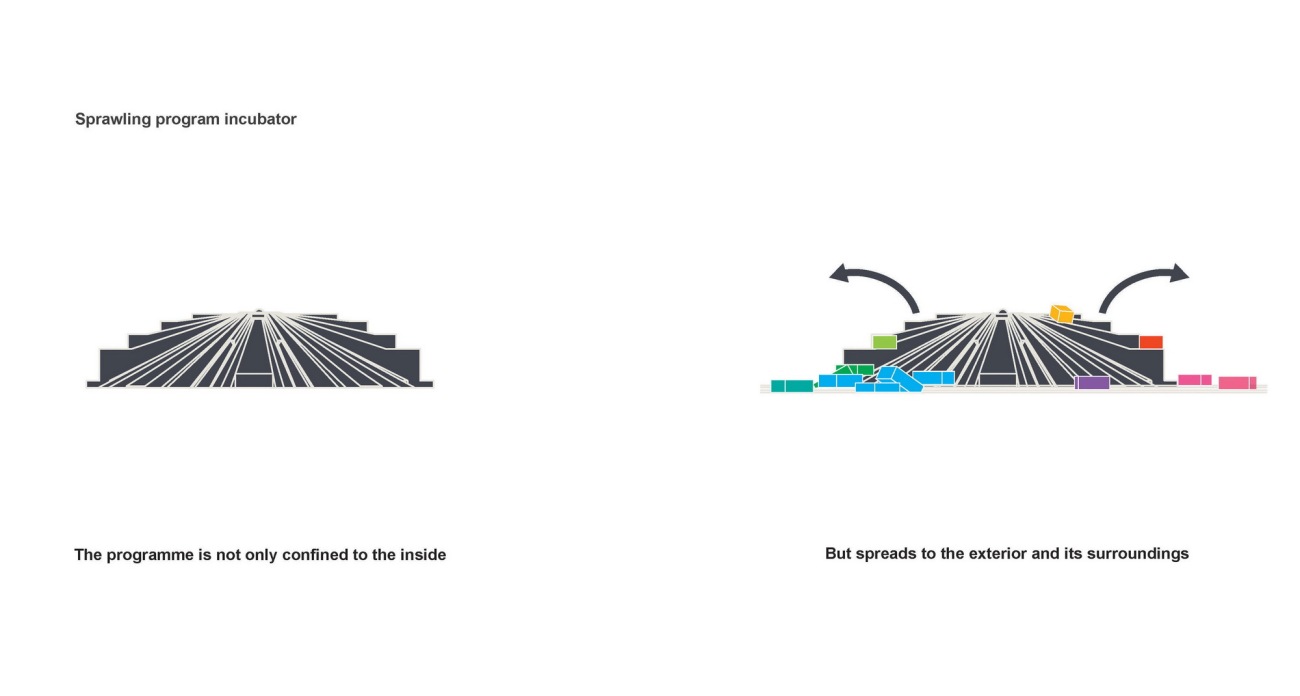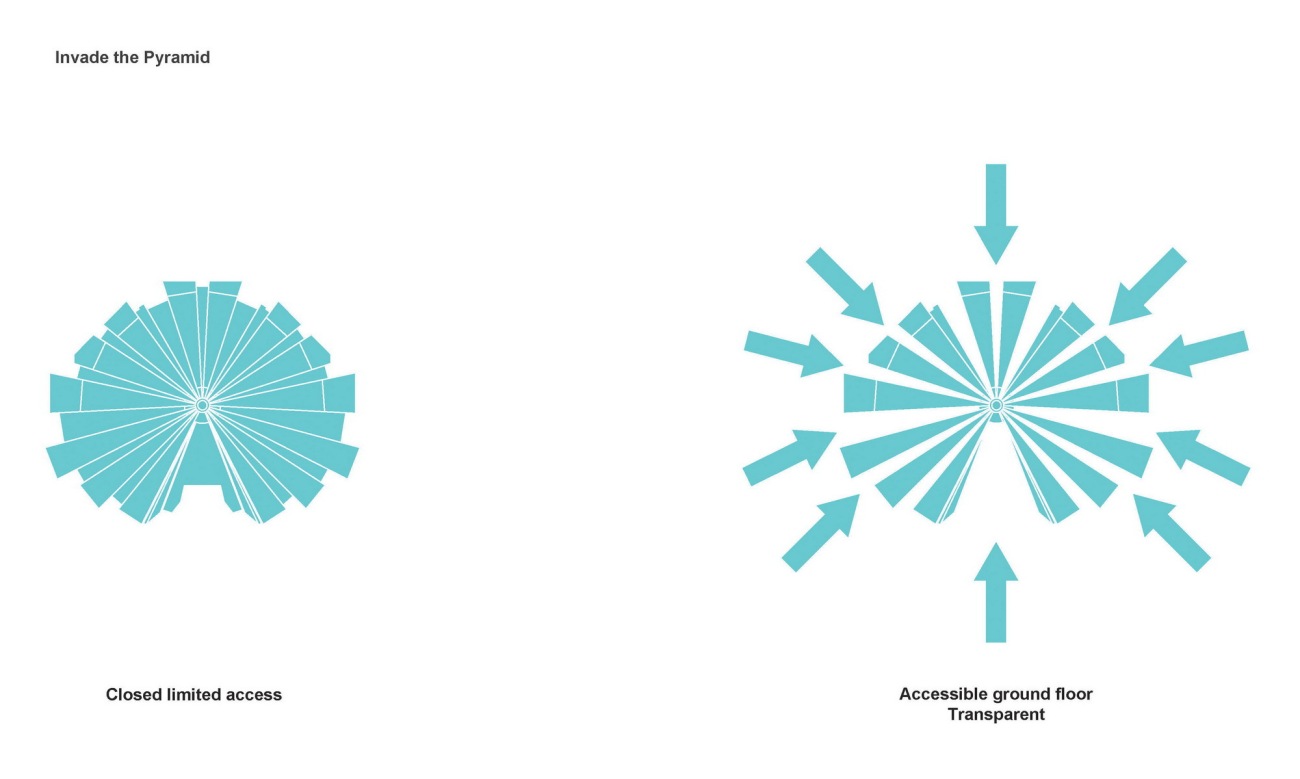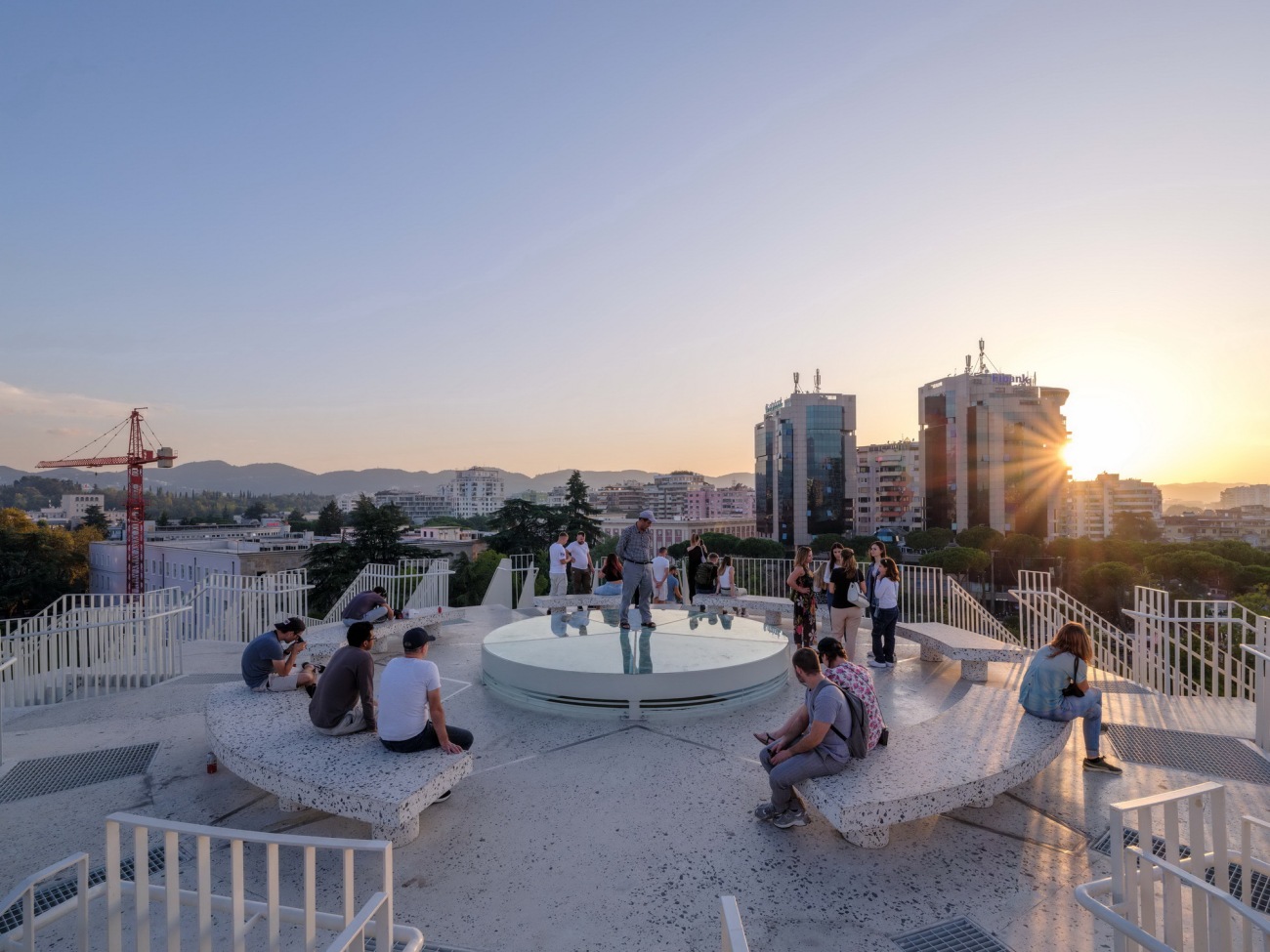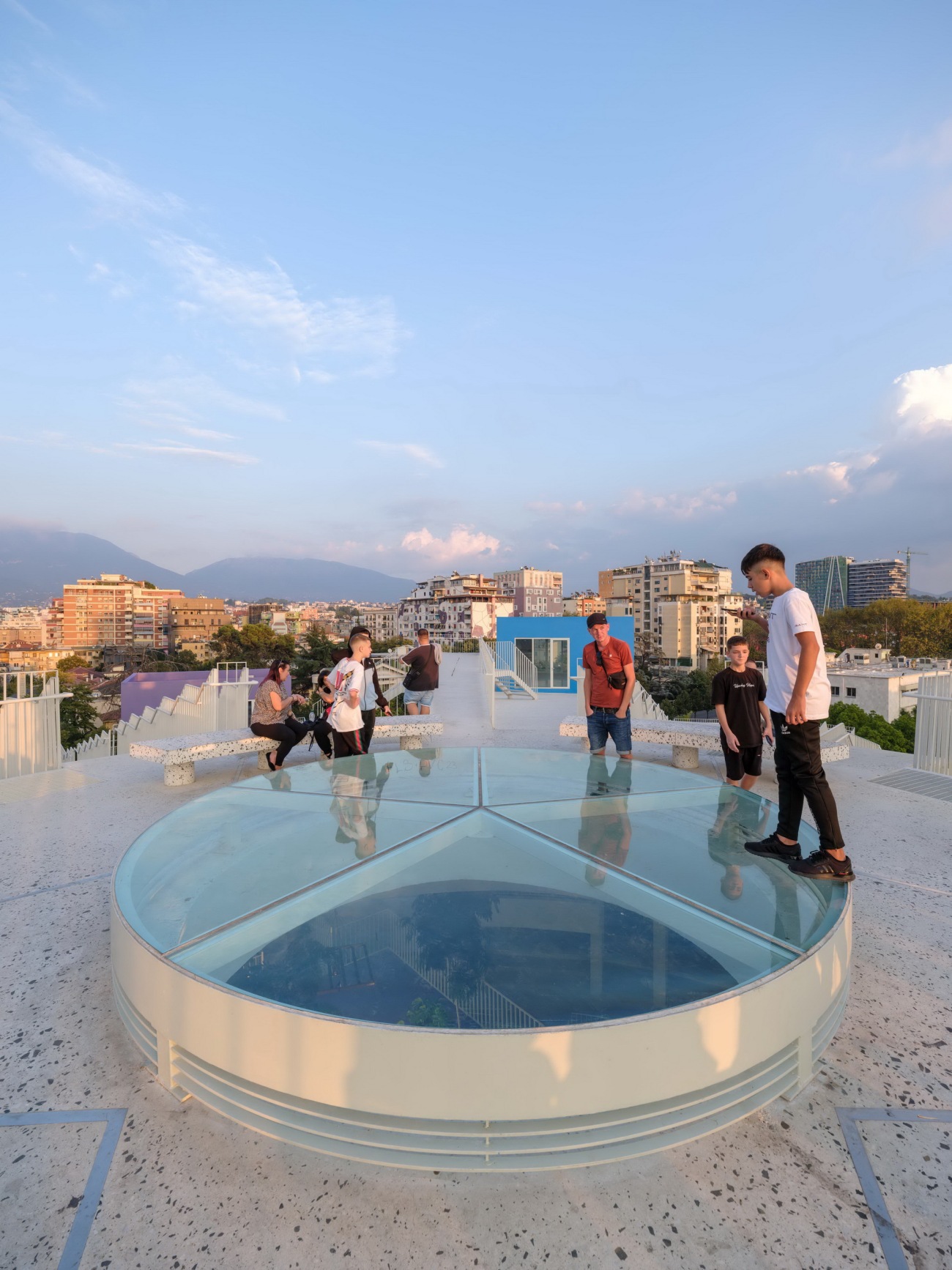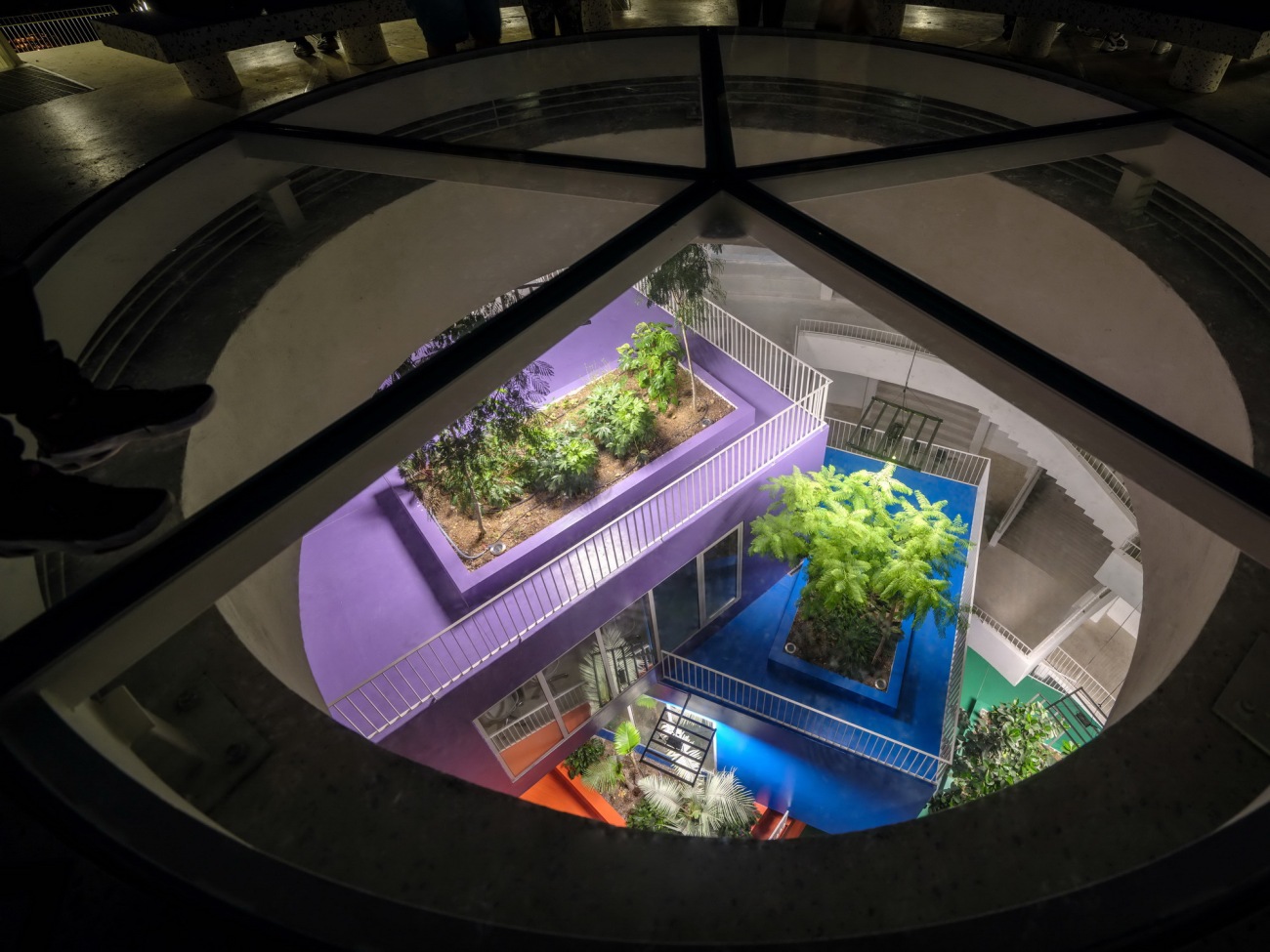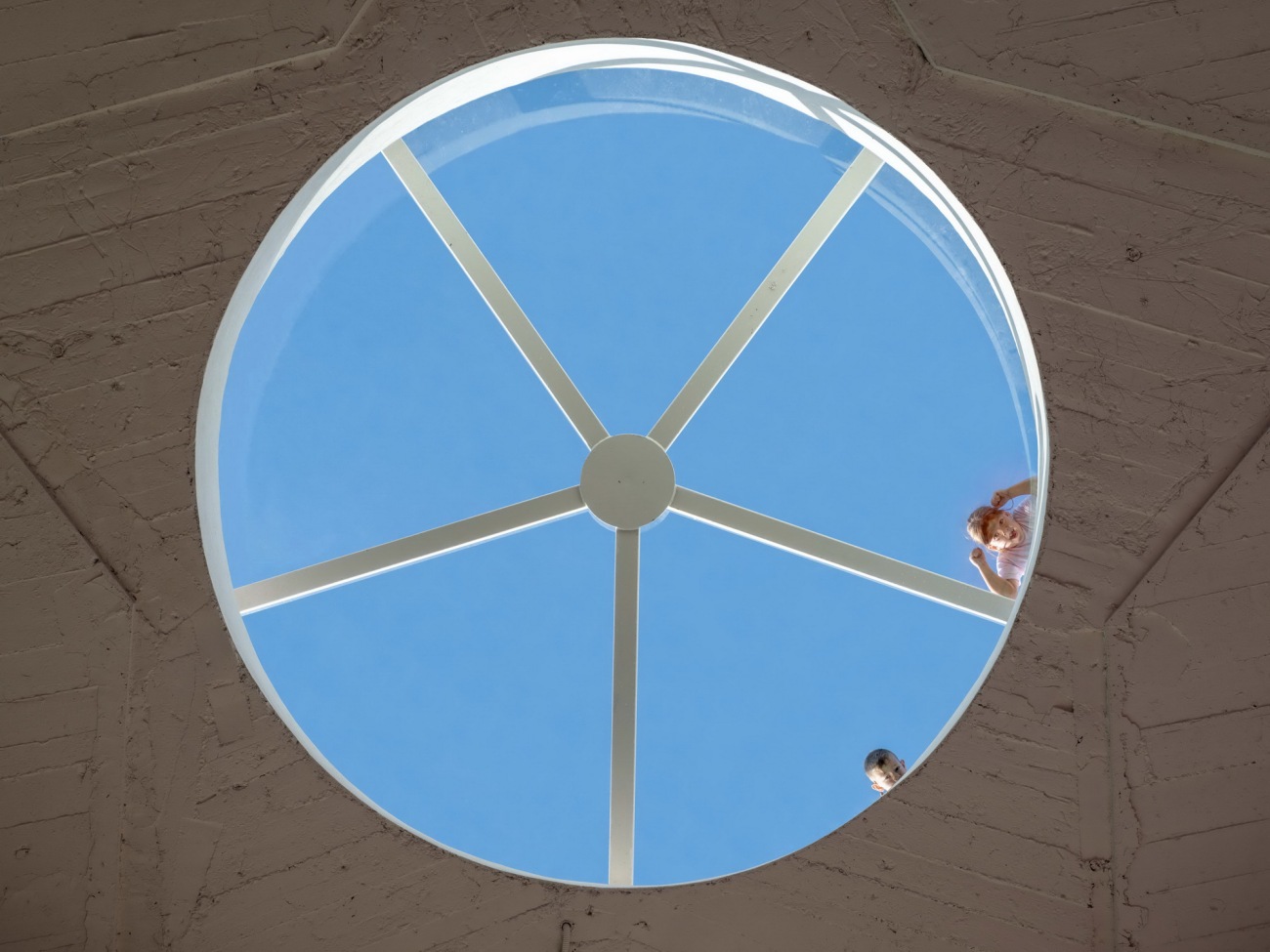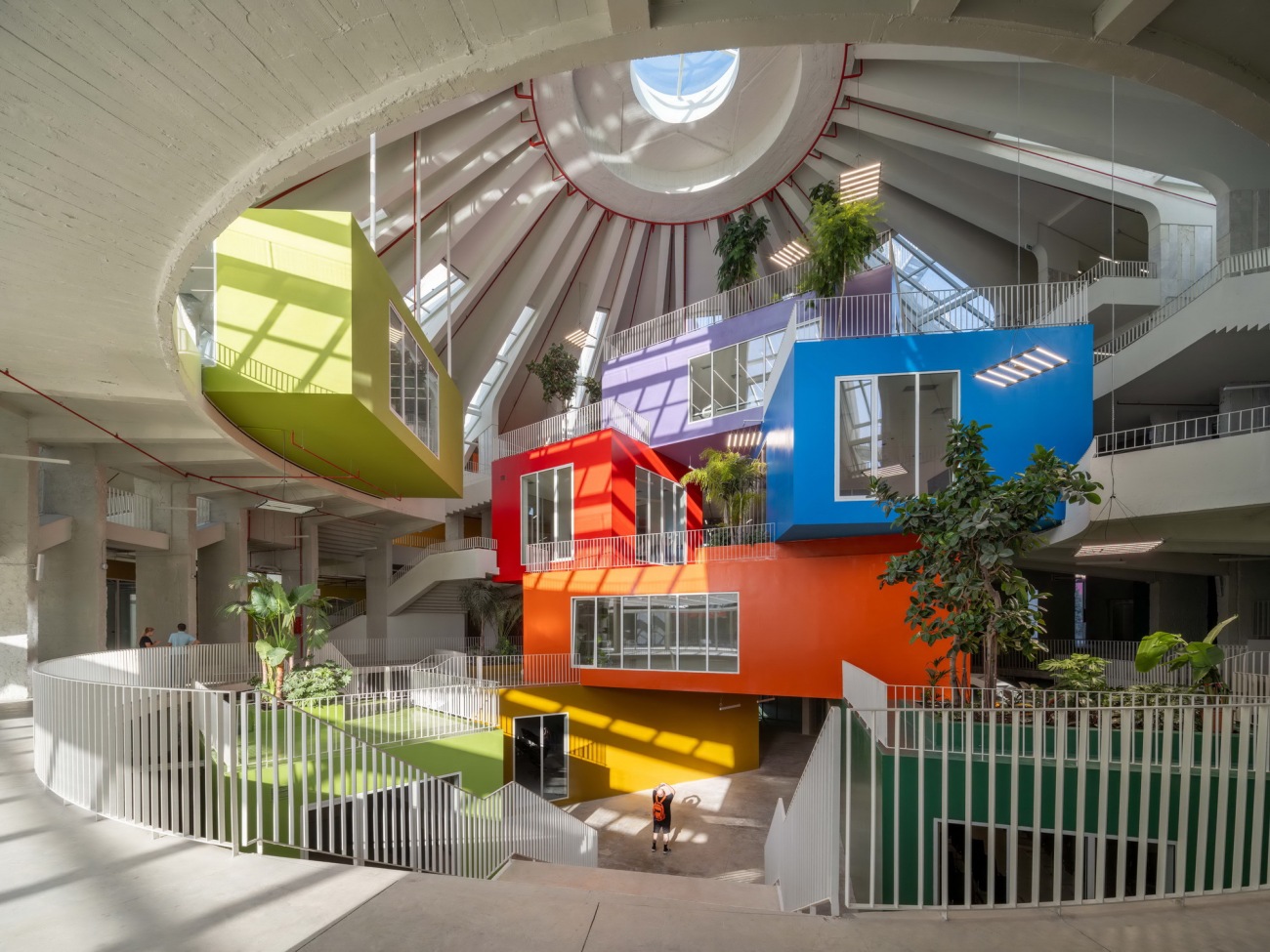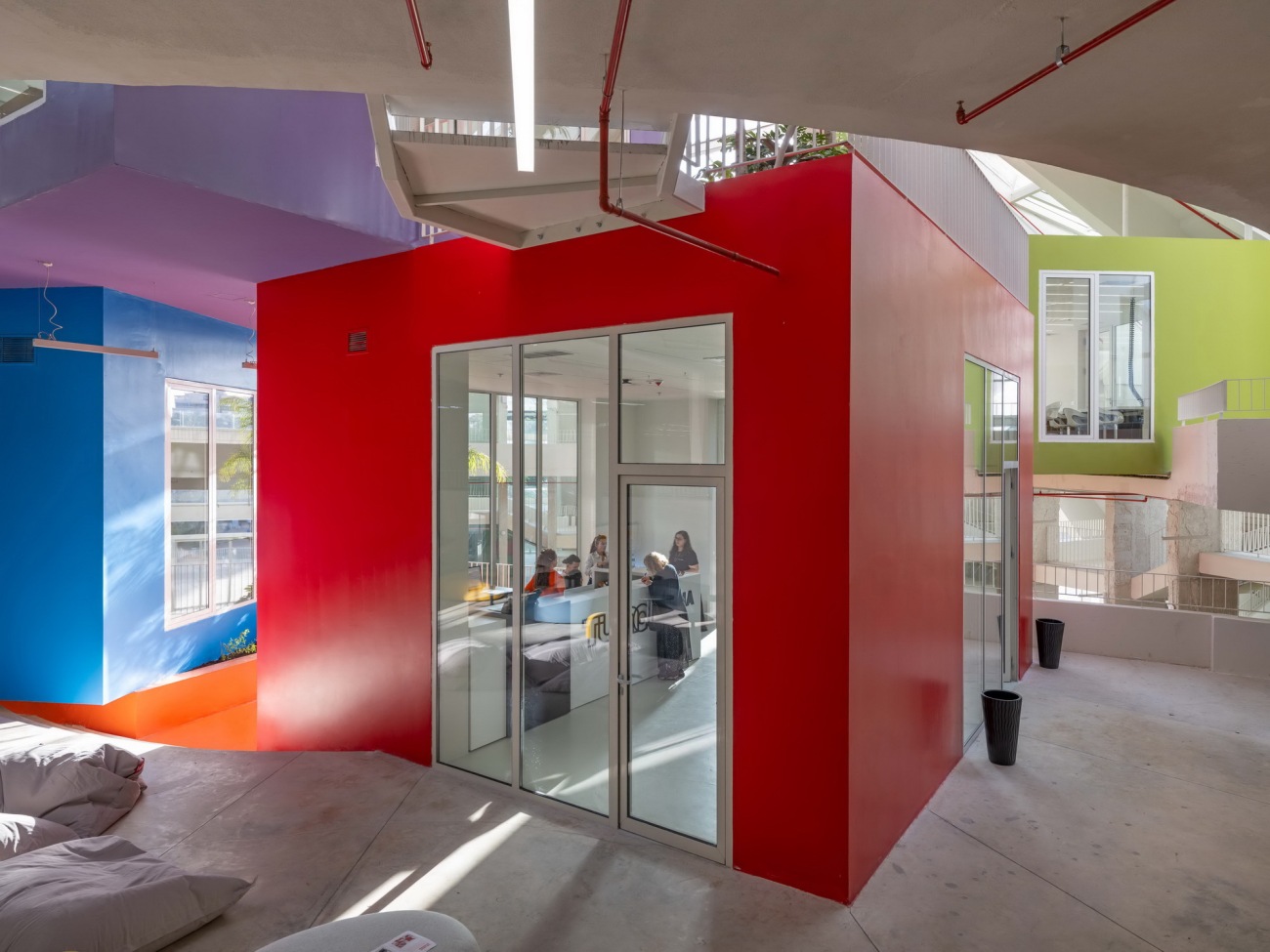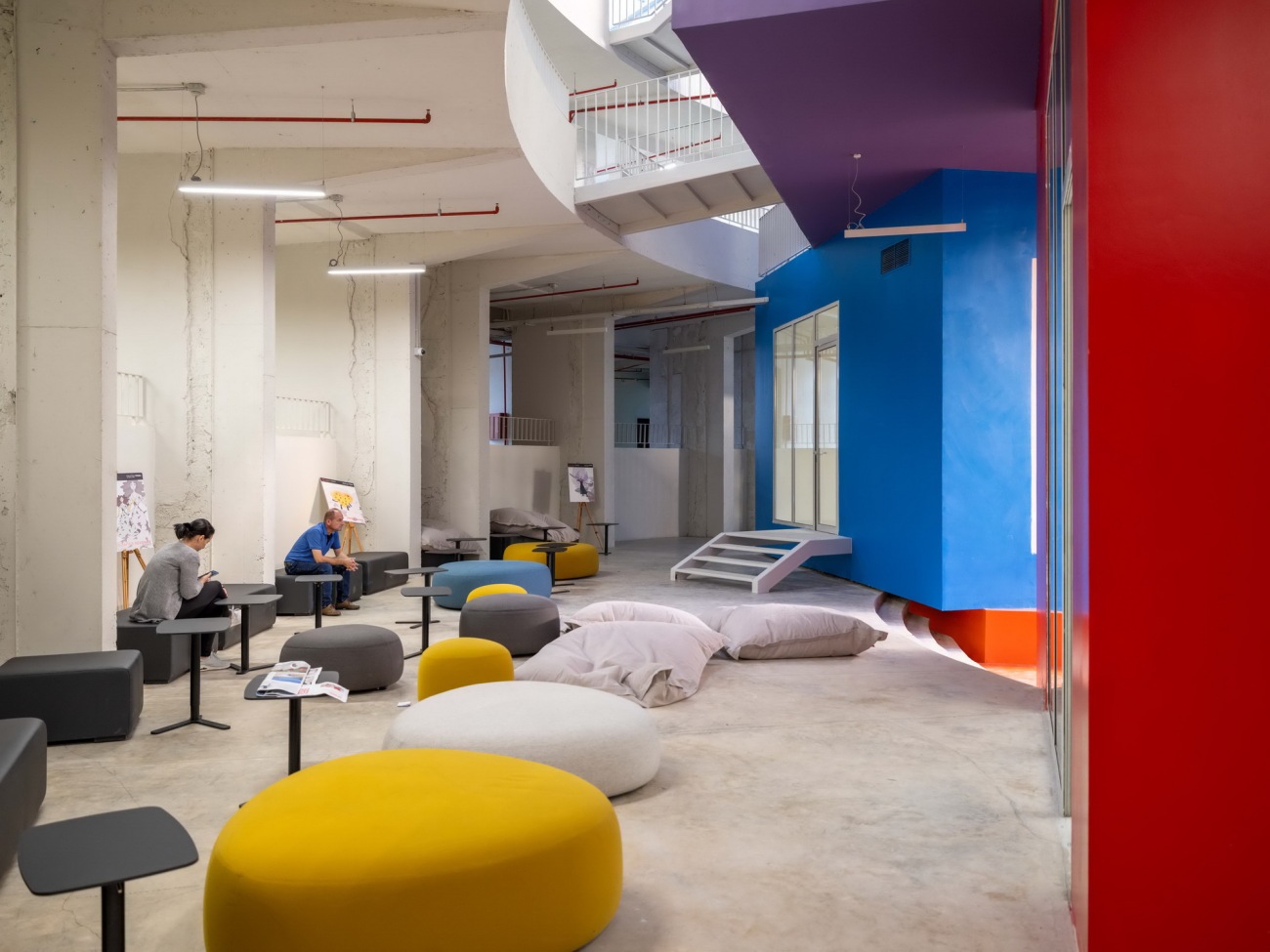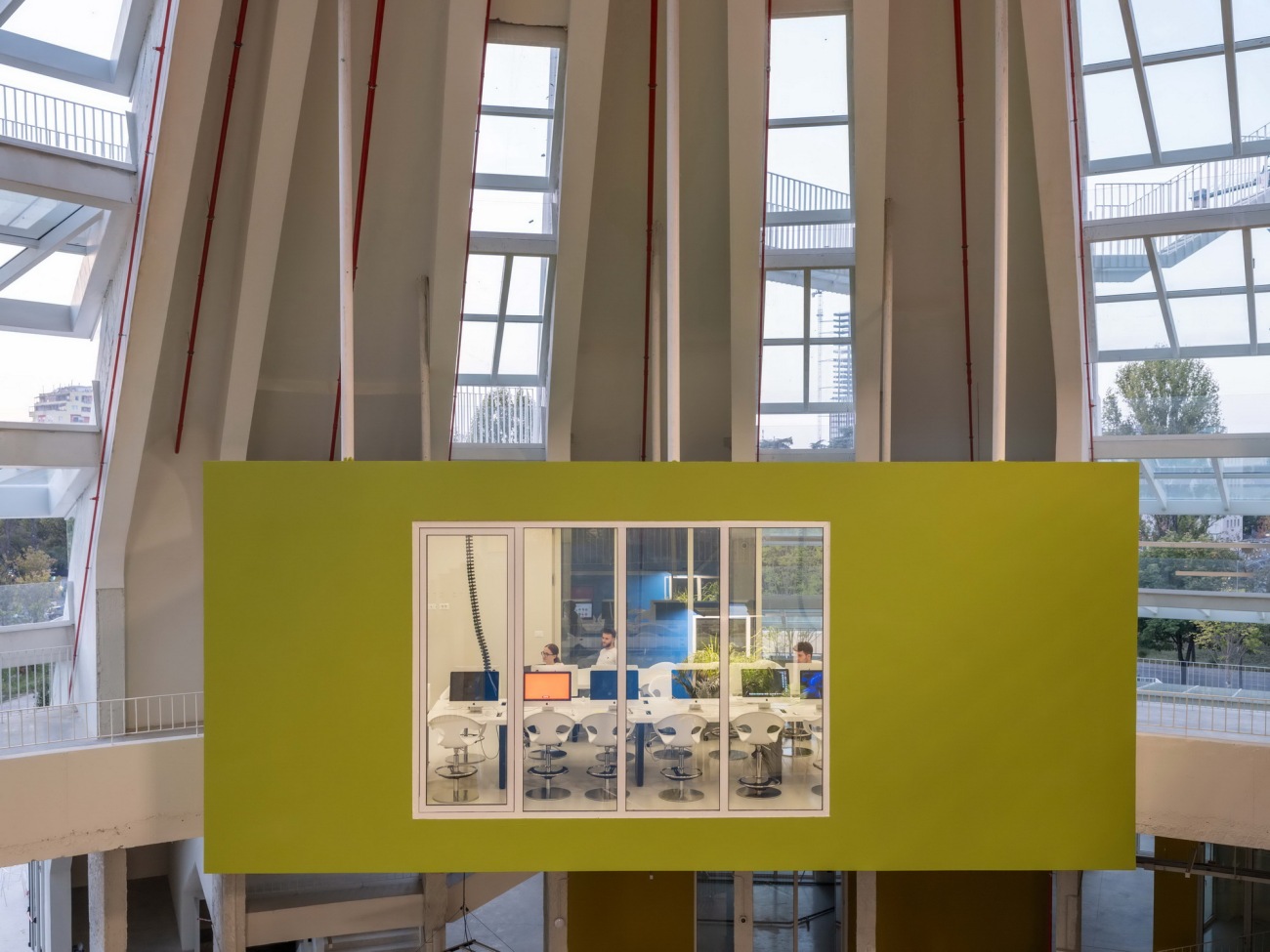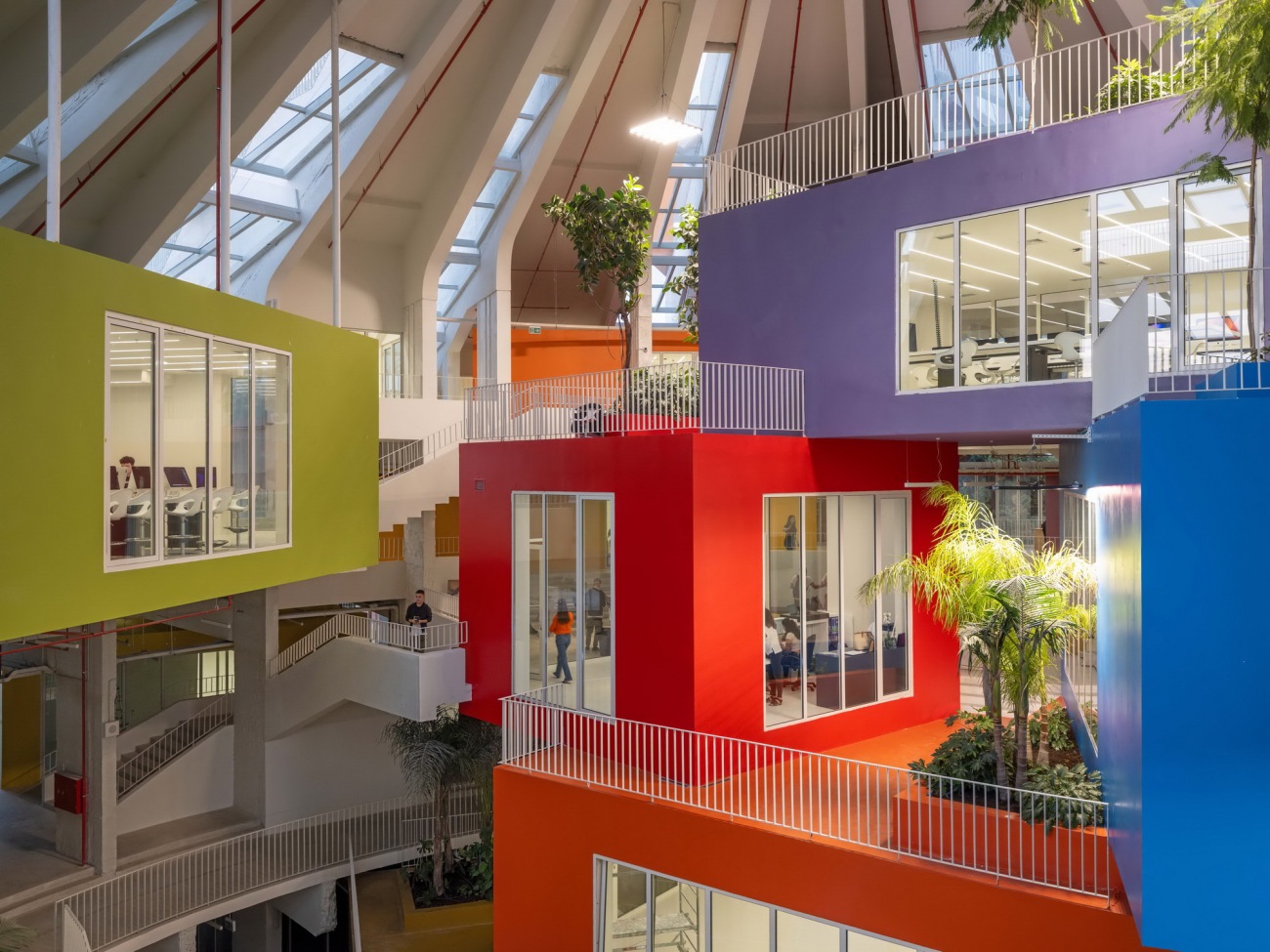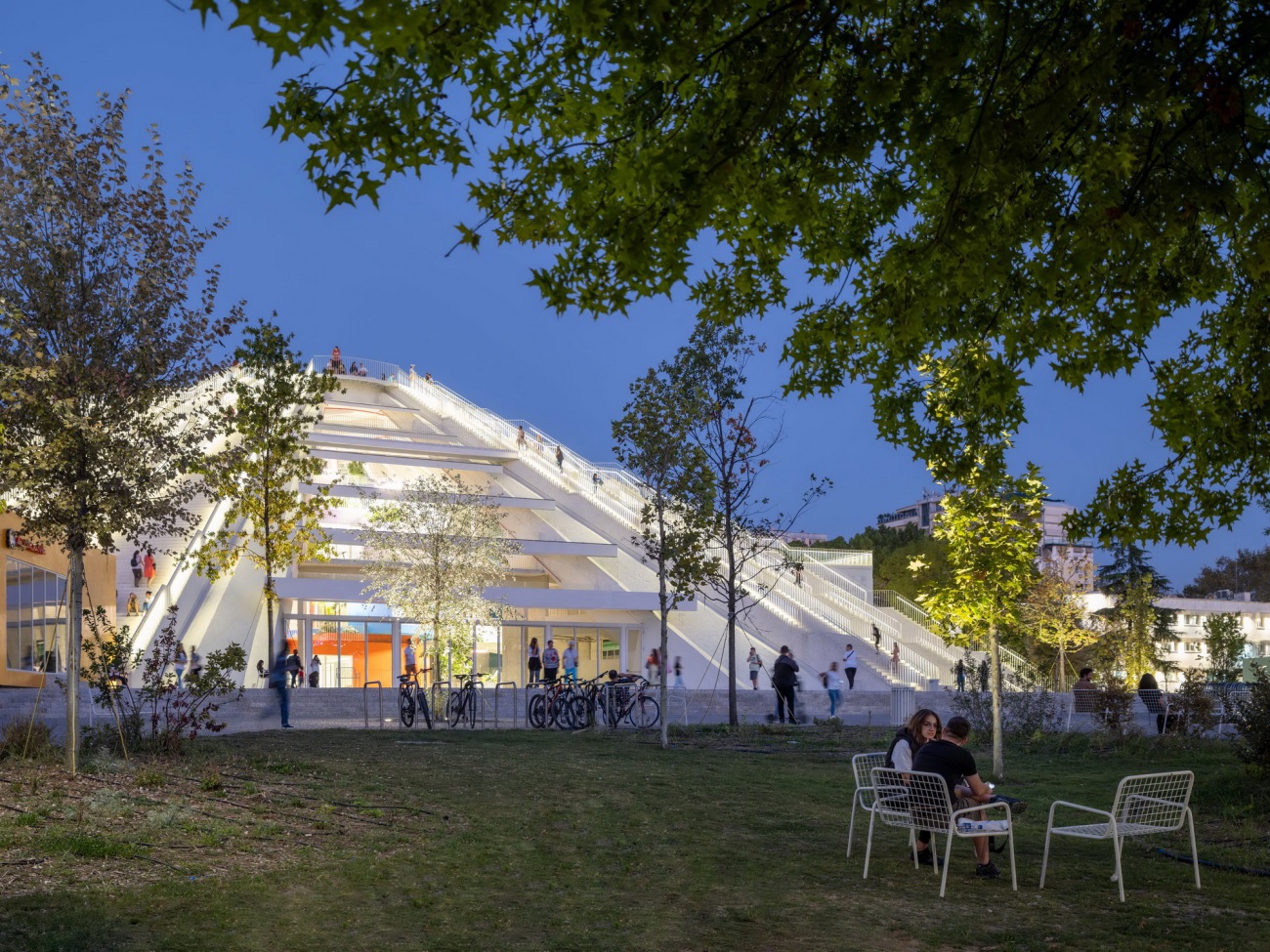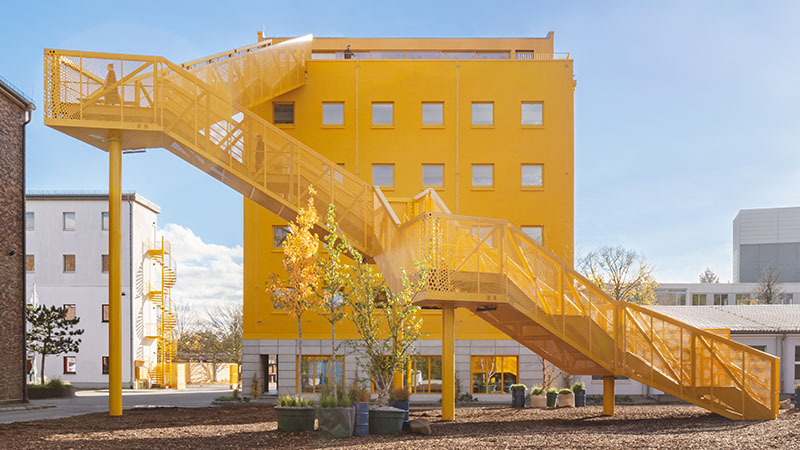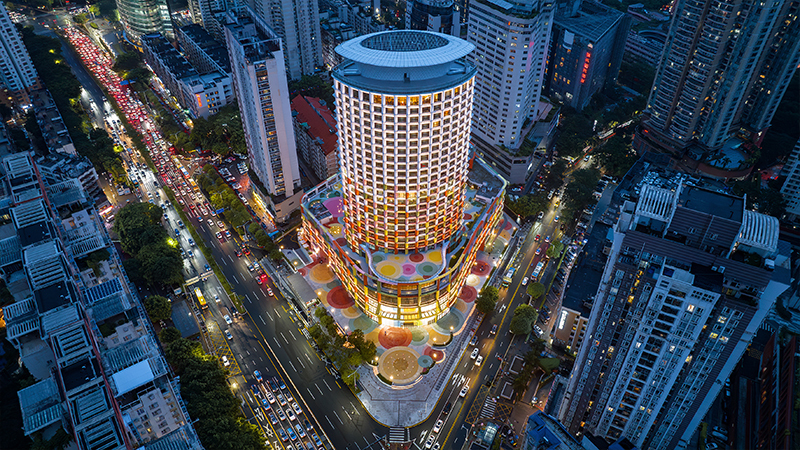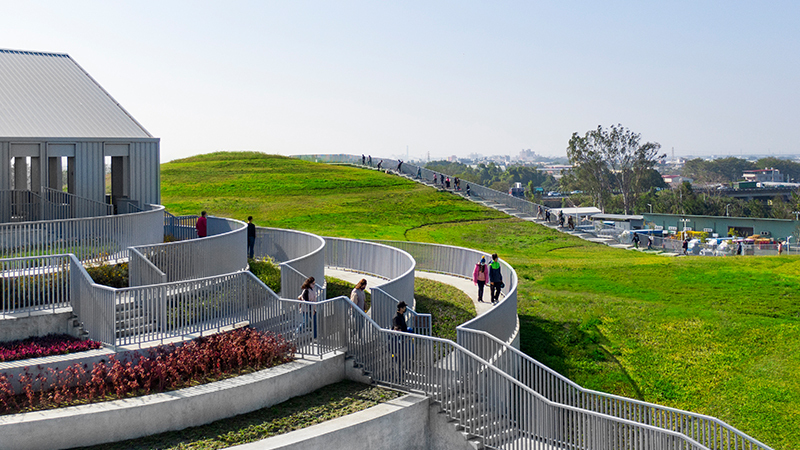在阿尔巴尼亚首都的中心,一个新型文化中心现已向公众开放。地拉那金字塔最初是为了纪念共产主义独裁者恩瓦尔·霍查而建的博物馆,现已由MVRDV进行了彻底的改造。在重新利用混凝土结构的基础上,金字塔现在成为一个位于新公园中的开放式雕塑。公园和雕塑周围散布着一组丰富多彩的箱子,这些箱子内设有咖啡馆、工作室、车间、初创企业办公室、孵化器、节庆活动场地以及供阿尔巴尼亚青年免费学习各种技术课程的教室。建筑的倾斜立面增加了阶梯,使得阿尔巴尼亚人民可以在前统治者的标志性建筑上自由漫步。
In the heart of Albania’s capital city, a new kind of cultural hub is now open and accessible to the public. The Pyramid of Tirana, originally built as a museum dedicated to the communist dictator Enver Hoxha, has been dramatically transformed by MVRDV. Reusing the concrete structure, the Pyramid is now an open sculpture in a new park. The park and the sculpture are home to an ensemble of colourful boxes, scattered in and around the original building that now house cafés, studios, workshops, start-up offices, incubators, festivals, and classrooms where Albanian youth will learn various technology subjects for free. Steps have been added to the building’s sloping façades, allowing the people of Albania to literally walk all over the showpiece of the former dictator.
地拉那的金字塔直到最近还是一个工地,但在去年夏天已经被广泛使用。除了阿尔巴尼亚人欣赏城市的美景,金字塔也被游客发现,成为一颗隐秘的宝石。随着欧盟峰会和建筑物于10月16日由TUMO正式宣布作为面向阿尔巴尼亚青少年的免费教育机构的正式开幕,金字塔现在正式回馈给了民众。
Even though Tirana’s Pyramid was until recently a building site, it was already heavily in use the past summer. Besides Albanians enjoying the city views, the Pyramid was also discovered by tourists as a hidden gem. With an EU Summit and the official inauguration of the building as a free educational faculty for Albanian teens by TUMO on October 16th, the Pyramid is now officially giving back to the people.
▽设计步骤,design steps.
地拉那金字塔于1988年首次开放,它经历了多种生命阶段。在共产主义政权垮台后,这座建筑曾被用作广播电台、夜总会、会议场地、广播中心,以及1999年科索沃战争期间,作为北约的基地。这不断变化的用途,以及之前未完成的翻新计划,导致了室内杂乱和昏暗。在最近的几十年中,如何处理这座建筑一直备受争议。然而,2015年公布的一项研究显示,大多数阿尔巴尼亚人反对拆除这座建筑,2017年政府宣布了将转变这座混凝土巨塔的计划。在阿尔巴尼亚-美国发展基金会(AADF)和蒂拉纳市政府的帮助下,决定将这座建筑转变为一个培育年轻阿尔巴尼亚人的环境。
First opened as a museum in 1988, the Pyramid of Tirana has led numerous lives. Since the fall of the communist regime, the building was variously used as a radio station, a nightclub, a conference venue, a broadcast centre and, during the 1999 Kosovo War, a base for NATO. The ever-changing uses, along with incomplete previous renovation plans, left behind a patchwork of alterations that made the interior cluttered and dark. In recent decades, the question of what to do with the building proved highly controversial. A study published in 2015, however, showed that the majority of Albanians were opposed to demolishing the building, and in 2017 this desire was honoured when the government announced plans to transform the concrete monolith. This promise was carried out with the help of the Albanian American Development Foundation (AADF) and the Municipality of Tirana, with the decision made to turn the building into a nurturing environment for young Albanians.
对许多阿尔巴尼亚人来说,金字塔是对政权的胜利象征,而MVRDV的设计受到了他们重新夺回这座建筑的方式的启发。在独裁者去世后,这座日渐破败的建筑长期以来一直是地拉那年轻人的聚会地,他们会攀爬倾斜的横梁,然后滑下来。现在,阶梯沿着倾斜的侧面上升,使各个年龄段的人都能爬到建筑的顶部。在西侧,有一部电梯可以让那些不能爬阶梯的人进入金字塔的顶部,而一根横梁包括一个倾斜的部分,人们仍然可以滑到底部。
For many Albanians the Pyramid is a symbol of victory over the regime, and MVRDV’s design was inspired by the way that they had reclaimed the building. After the death of the dictator, the deteriorating structure had long served as a hangout spot for Tirana’s youth, who would climb the sloping beams and – not without risk – slide back down. Now, steps rise up the sloping sides, allowing people of all ages to climb to the top of the building. On the western side, a lift gives access to the top of the Pyramid for those who can’t climb the steps, while one beam incorporates a sloped section where people can still slide to the bottom.
▽概念示意图,concept diagram
▽交通连接图,Transport connection map.
MVRDV创始合伙人Winy Maas表示:“第一次看到地拉那的年轻人在金字塔上自由行走,我被它的象征意义和令人难以置信的乐观情感深深触动。要记住,在那个压迫阿尔巴尼亚人口贫困的时代,这是共产主义国家曾经建造的最昂贵的建筑,我们在改造中去除了所有美化独裁统治的象征。我们确实保留了一些原始细节,以便让游客了解建筑的黑暗历史。这座结构在公园中完全呈现出废墟状态,所有这些箱子都“侵占”在结构内外。曾经讽刺地称为‘恩瓦尔·霍查陵墓’,经过改造的金字塔现在已成为人民的纪念碑,象征着他们战胜和幸存下来的独裁者。”
“The first time I saw the Pyramid being walked all over by the youth of Tirana, I was deeply touched by its symbolism and by its incredible optimism”, says MVRDV founding partner Winy Maas. “Keeping in mind this was the most expensive building the communist state had ever realised in a time when the oppressed Albanian population was living in poverty, we removed all symbols glorifying the dictatorship in our transformation. We did keep some of the original details so visitors are also aware of the building’s dark past. The structure is completely open as a ruin in the park, and all these boxes are ‘squatting’ in and around the structure. Once sardonically called the ‘Enver Hoxha Mausoleum’, the transformed Pyramid has now become a monument for the people and their ability to overcome and outlive dictators.”
MVRDV的设计团队的工作涵盖并环绕着现有的建筑结构,将这个结构作为蓝图,增加了公共可访问的空间以及用于教育和活动的箱子。一堆彩色的箱子里面包含了教育和活动用的房间,散布在建筑物及其周围的公园中。这些多彩的附加部分也位于建筑物的顶部和前方的公园中,使周围环境呈现出一种节日氛围,甚至有点像“占领”了这片区域。
The work of MVRDV’s design team encompasses and encircles the existing structure, using the structure as a blueprint to which publicly accessible spaces and boxes for education and events were added. A stack of coloured boxes containing rooms for education and events are scattered in and around the structure and the park. These colourful additions are also found on top of the structure, and in the park at the front of the building, giving the surroundings the atmosphere of a festival and even a “squatted” area.
这些空间中大约一半将用于非营利性教育机构TUMO Tirana,该机构为12至18岁的年轻人提供免费的课后教育,涵盖新技术领域,如软件、机器人技术、动画、音乐和电影。TUMO于2011年在亚美尼亚成立,随后在整个欧洲蔓延,它有助于提供教育和机会,可以成为对抗威胁阿尔巴尼亚等国家经济的“人才外流”的工具。另一半彩色箱子将对公众开放,提供租赁空间,包括咖啡馆、餐厅、初创企业办公室和实验室、孵化器、工作室等。
Around half of these spaces will house non-profit educational institution TUMO Tirana, which provides free afterschool education for 12- to 18-year-olds in new techniques such as software, robotics, animation, music, and film. Founded in Armenia in 2011 and since then spreading throughout Europe, TUMO helps to provide education and opportunities that can be a tool against the “brain drain” that threatens the economy of countries like Albania. The other half of the coloured boxes will be accessible to the public, hosting rental spaces for cafés, restaurants, start-up offices and labs, incubators, studio spaces, and more.
金字塔的改造展示了如何使一座建筑适应新时代,同时保留其复杂的历史,证明了历史悠久的野兽派建筑适合重新利用。这个项目还满足了联合国提出的一系列可持续发展目标。与其浪费地拆除这座建筑,不如根据循环经济原则对其坚固的混凝土外壳进行改造。由于大部分建筑结构在大部分时间对周围环境开放,只有用于教育项目的附加箱子需要进行气候控制,从而降低了能源消耗。在建筑物的新用途中,社会可持续性得到提升,教育项目推动了教育事业的发展,为下一代的成功做好了准备。
The transformation of the Pyramid shows how a building can be made suitable for a new era, while at the same time preserving its complex history, and demonstrates that historic brutalist buildings are ideal for reuse. The project also meets a number of the Sustainable Development Goals outlined by the United Nations. Rather than wastefully demolish the structure, its robust concrete shell is adapted along circular economy principles. As the majority of the structure is open to the surroundings for most of the year, only the added boxes housing the educational program need to be climate-controlled, reducing energy consumption. Social sustainability is advanced in the building’s new use, with the educational programme advancing education and preparing the next generation for success.
Facts
Project Name: The Pyramid of Tirana
Location: Tirana, Albania
Year: 2018-2023
Client: Albanian-American Development Foundation (AADF)
Size and Programme: 11,835m2 - educational facility, commercial, public space
Max Height: 24.5m
Height (Pyramid centre): 20.2m
Credits
Architect: MVRDV
Founding Partner in charge: Winy Maas
Partner: Stefan de Koning
Design Team: Ronald Hoogeveen, Stavros Gargaretas, Guido Boeters, Angel Sanchez
Navarro, Boris Tikvarski, Jasper van der Ven, Mirco Facchinelli, Manuel Magnaguagno, Leo
Stuckardt
Visualisations: Antonio Luca Coco, Luca Piattelli, Jaroslaw Jeda, Luana La Martina,
Gianlorenzo Petrini
Strategy and Development: Willeke Vester, Daan van Gool
Copyright: MVRDV Winy Maas, Jacob van Rijs, Nathalie de Vries
Partners:
Albanian-American Development Foundation (AADF), Municipality of Tirana; Albania Ministry
of Culture
Education partner: TUMO Tirana
Co-architect: iRI Architecture
Contractor: Fusha shpk
Project coordination: Albanian-American Development Foundation (AADF)
Landscape architect: iRI; JESHILE; MVRDV
Structural engineer: ARUP; Gentian Lipe; Luan Murtaj
MEP: ARUP; iRI; Nikolin Risilia; Artur Dado; Isuf Kore
Monuments Expert: Daniel Gjoni
Cost calculation: iRI Architecture
Environmental advisor: Arben Liçi
Photographs: © Ossip van Duivenbode
更新日期:2023-10-23 17:52:42
非常感谢 MVRDV 带来的精彩项目, 查阅更多Appreciations towards MVRDV for sharing wonderful work on hhlloo. Click to see more works!
